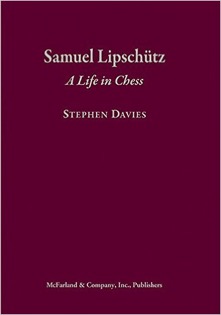Samuel Lipschutz, A Life in Chess
Stephen Davies

Many chess players would be hard pressed to name U.S. Champions between Paul Morphy and Henry Nelson Pillsbury. Fortunately North Carolina based McFarland & Company has done much to rectify this situation. Four players held the title between these giants of American chess and MacFarland has previously published books on Jackson Showalter and Albert Hodges. A work on the third member of this quartet Samuel Lipschutz is now available, leaving only George Mackenzie unaccounted for.
McFarlands latest offering is SAMUEL LIPSCHUTZ, A LIFE IN CHESS by Stephen Davies. This handsomely produced book is the first comprehensive look at the man who defeated Showalter in convincing fashion (+7 -1 =7) in 1892 to take the title. All 15 games of this important match, held after the previous title-holder Mackenzies death the previous year, are given. Many appear with annotations by Steinitz from various newspapers of the day.
Davies writes that the present time is a golden age for those interested in the history of the game. The last half of the 19th century and the beginning of the 20th saw chess columns in almost every important newspaper with many cities having more than one. Until recently accessing these columns involved a lot of effort. At a minimum it meant going to a library and slowly going through newspapers on microfilm. This was a tedious process to say the least. Often the work involved was greater as most public libraries have limited holdings necessitating the need to order material on inter-library loan. In extreme cases the only way to gain access to the material was to travel to a distant library.
This is no longer the case. Now its possible to access hundreds of newspapers and one look at the bibliography for SAMUEL LIPSCHUTZ, A LIFE IN CHESS makes it clear that Stephen Davies has made ample use of them. This is important as even information about something as basic as Lipschutzs first name (Samuel or Solomon) is unclear. Davies has uncovered much new material in this work which includes 249 games annotated games including ones involving Emanuel Lasker and Jose Capablanca.
Lipschutz, who suffered from tuberculosis (he died at only 42), was in Los Angeles from late 1893 to early 1895 and appears to have been the first U.S. Champion to visit the West Coast. This reviewer, who works at the Mechanics Institute Chess Club in San Francisco, was curious in finding out what Davies had uncovered about this relocation which was motivated by health concerns. There are nine pages in SAMUEL LIPSCHUTZ, A LIFE IN CHESS on his sojourn in Southern California which reveals previously unknown information about chess in Los Angeles which had only 50,000 people in 1890.
Lipschutz and Dr. Walter Romaine Lovegrove of San Francisco, the best California player of the time, played several games during the latters visit to Los Angeles in 1894. This information was previously known but new are the extensive plans for a visit by Lipschutz to San Francisco, the largest city West of the Mississippi in 1890 (population 300,000). Unfortunately it did not happen, but Davies is to commended for his digging. This is but one of many examples where he has uncovered new information.
SAMUEL LIPSCHUTZ, A LIFE IN CHESS fills an important gap in chess literature and makes for interesting reading for those interested in American chess history pre-1900.
Highly Recommended.
